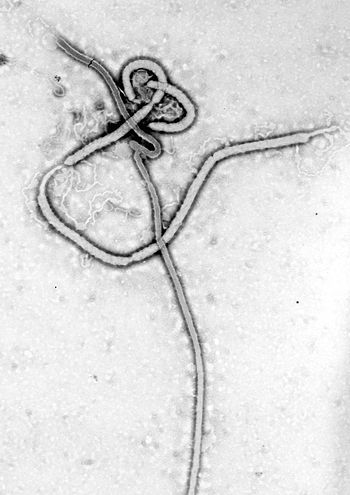324
| Transmission Electron Micrograph of the Ebola Virus. Hemorrhagic Fever, RNA Virus. (Photo credit: Wikipedia) |
The epidemic of Ebola virus that began in December of 2013 has already claimed lives of over 2000 people, mostly in the West African region, where the outbreak occurred. The recent death of a Liberian citizen who travelled to the United States, probably after contracting an infection in his home country has raised further fears of how quickly the virus is being transmitted and is able to increase its reach.
To make matters worse, there is no drug that is 100% effective against the virus and the few drugs that have been given limited clearances such as Zmapp and Brincidofovir are either out of stock or not available in enough numbers to contain the spread. The only means of containing the infection right now are preventing its further spread by following stringent protocols of containment and screening travellers who are flying out of affected countries and quarantining them on arrival.
As other pharmaceutical companies test their potential drugs in clinical trials, stocks of partially effective drugs are expected to be restored and containment of the disease will become easier. However, this is just one type of Ebola virus that we have encountered so far and there are at least four other types in this family that are equally infectious and disruptive. Therefore, along with drugs, we need vaccines that will give us immunity against these viruses, something that also being looked into.
But researchers at the University of Utah have identified the functionally critical region of Ebola virus, which when targeted with drugs will lead to more effective treatment of the disease. What makes this finding interesting is that this critical region is found in not only the Zaire Virus (responsible for current epidemic) but also seen in other Ebola viruses, making it an excellent candidate as a drug target. This will not only help us tackle this epidemic of Ebola, but also prepare us for any incident involving Ebola Viruses even in the future.
Luckily, the critical region can be targeted with a class of drugs called D-peptides. These D-peptides are inexpensive to manufacture and also not digested by enzymes in the body, making them even more effective. Similar D-peptides are also being developed for HIV and will soon enter clinical studies.
Reference:
Clinton TR, Weinstock MT, Jacobsen MT, Szabo-Fresnais N, Pandya MJ, Whitby FG, Herbert AS, Prugar LI, McKinnon R, Hill CP, Welch BD, Dye JM, Eckert DM, & Kay MS (2014). Design and characterization of ebolavirus GP prehairpin intermediate mimics as drug targets. Protein science : a publication of the Protein Society PMID: 25287718





4 comments
It's funny: We just created an amazing Infographic on "Ebola Virus. What Is It? Interesting Facts" because we found people were missing the essential facts about Ebola.
Check it out: http://www.BioMedicalWasteSolutions.com/What-Is-Ebola/
Let me know what you think:)
Thank you for letting us know about this infographic. It is very informative and should be helpful for a lot of people.
Thank you for your interest. Kindly share your name and email address with me. I want to share interesting content regarding to Ebola with you.
We can be contacted at coffeetablescience[at]gmail[dot]com